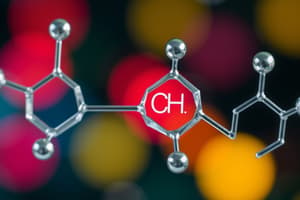Podcast
Questions and Answers
What is a Chemical Formula?
What is a Chemical Formula?
- The absolute number of atoms in a compound
- The relative number of atoms of each kind in a chemical compound (correct)
- A formula that only shows the cation
- None of the above
What is a Molecular Formula?
What is a Molecular Formula?
The number of atoms of each element contained in a single molecule of the compound.
Define Ionic Compound.
Define Ionic Compound.
A lattice of positive and negative ions held together by mutual attraction.
What is a Formulas Unit?
What is a Formulas Unit?
What are Monatomic Ions?
What are Monatomic Ions?
Define Binary Compounds.
Define Binary Compounds.
What is Nomenclature?
What is Nomenclature?
Describe the Stock System of Nomenclature.
Describe the Stock System of Nomenclature.
What is the Old System for naming Binary Molecules?
What is the Old System for naming Binary Molecules?
Define Hydrocarbons.
Define Hydrocarbons.
What are Oxyanions?
What are Oxyanions?
Define Acid.
Define Acid.
What are Binary Acids?
What are Binary Acids?
Define Oxyacids.
Define Oxyacids.
What is Salt?
What is Salt?
What are Oxidation Numbers/States?
What are Oxidation Numbers/States?
Define Molecular Mass.
Define Molecular Mass.
What is Formula Mass?
What is Formula Mass?
What is Molar Mass?
What is Molar Mass?
Define Percentage Composition.
Define Percentage Composition.
What is an Empirical Formula?
What is an Empirical Formula?
Define Molecular Formula.
Define Molecular Formula.
Flashcards are hidden until you start studying
Study Notes
Chemical Formulas and Compounds
- Chemical Formula: Represents the relative number of atoms of each kind in a chemical compound.
- Molecular Formula: Specifies the number of atoms of each element in a single molecule of the compound.
Types of Compounds
- Ionic Compound: Formed from a lattice of positively and negatively charged ions due to mutual electrostatic attraction.
- Formulas Unit: Indicates the simplest ratio of a compound's positive ions (cations) to negative ions (anions).
- Monatomic Ions: Ions created from a single atom, acting as building blocks for compounds.
- Binary Compounds: Compounds consisting of just two different elements, representing a fundamental type of chemical combination.
Nomenclature and Naming Systems
- Nomenclature: The naming convention for binary ionic compounds, combining cation and anion names, with cations named first.
- Stock System of Nomenclature: Utilizes oxidation numbers, with Roman numerals indicating an ion's charge, shown in parentheses after the metal's name.
- Old System for Naming Binary Molecules: Employs prefixes (mono, di, tri, etc.) to denote the number of each element; the second element's name ends in -ide.
Classes of Chemical Compounds
- Hydrocarbons: Molecular compounds that consist only of carbon and hydrogen atoms.
- Oxyanions: Polyatomic ions that contain oxygen, often integral in various chemical reactions.
- Acid: A class of compounds that usually refers to their aqueous solutions with specific properties, distinct from the pure compound.
- Binary Acids: Composed of two elements, typically hydrogen and one halogen (e.g., fluorine, chlorine).
- Oxyacids: Contain hydrogen, oxygen, and another element, often a nonmetal.
Additional Concepts
- Salt: An ionic compound formed from the reaction of an acid, generating a cation, and an anion from the acid.
- Oxidation Numbers/States: Indicate the degree of oxidation of an atom in a compound, essential for understanding electron transfer in reactions.
- Molecular Mass: The mass of a molecule, integral for calculations in stoichiometry.
- Formula Mass: Measured in amu, equal to the molar mass for a given compound.
- Molar Mass: Expressed in g/mol, numerically the same as formula mass, important for converting between mass and moles.
- Percentage Composition: Represents the mass percentage of each element present in a compound, useful for analysis.
- Empirical Formula: Shows the smallest whole-number mole ratio of the elements in a compound, possibly differing from the correct molecular formula.
- Molecular Formula: The actual formula that defines the composition of a molecular compound, revealing the true number of atoms involved.
Studying That Suits You
Use AI to generate personalized quizzes and flashcards to suit your learning preferences.




